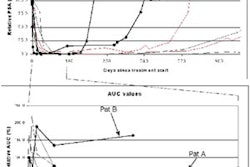Osteoporosis may remain undetected in more than 30% of men over 65 years old, according to a study that used dual-energy x-ray absorptiometry (DEXA) bone densitometry screening. Although DEXA screening is a mainstay in diagnosing osteoporosis in postmenopausal women, physicians order it less routinely in men.
According to lead investigator Dr. Arthur Swislocki, only 6.8% of male patients in a nursing home rehabilitation unit had been previously screened or were receiving treatment, but 30.5% had DEXA-confirmed osteoporosis.
Swislocki, who presented these findings at the 2002 meeting of the Endocrine Society in San Francisco last month, is the assistant chief of medical services at the Veterans Affairs (VA) Northern California Health Care System in Martinez, CA. He also is an associate professor of internal medicine at the University of California, Davis School of Medicine.
"Although 6.8% of the patients had been screened for osteoporosis and were being treated for it, approximately one-third of them have it," Swislocki said. "This is a higher prevalence than we thought."
In this study funded by Merck Pharmaceuticals, the charts of 521 consecutive men were reviewed. Of these patients, 32 had already been screened or were receiving therapy for osteoporosis, Swislocki said. The investigators recruited the remainder for osteoporosis evaluation, and have now obtained bone density scans for 76 men of the hip and lumbar spine with DEXA and routine clinical biochemistry studies.
Of these, 23 had osteoporosis, which was defined as a T-score of less than -2.5. The average hip T-score in men with osteoporosis was -3. In the osteoporosis-free men, the average hip T-score was -0.71. The average spine T-score was lower in men with osteoporosis, -0.93, compared to an average spine T-score of 0.21 for men with no osteoporosis. Although many of the men with hip osteoporosis had normal spine T-scores, hip and spine bone density were correlated.
The average ages of both groups were 69.1 years for men with osteoporosis and 65.3 years for men with no osteoporosis. The groups’ laboratory results were similar. Those scores consisted of testosterone and parathyroid hormone levels, 25-OH-vitamin D levels, and 24-hour urinary calcium.
"Hip osteoporosis is more common than anticipated in this unscreened population," the investigators stated, noting that the findings may warrant more routine screening of these patients.
"Bone-mineral densitometry is being used more widely than it was five or 10 years ago," commented radiologist Dr. William Spies on the study’s findings. "Osteoporosis can be an issue with men as well as with women. Although this study by itself is rather small, osteoporosis is probably more of a problem than we previously thought, but we need further study to determine the exact extent." Spies is the associate director of nuclear medicine and an associate professor of radiology at Northwestern University in Chicago.
More data is needed before physicians can assume a 30% osteoporosis prevalence rate in elderly men across the board, Swislocki said.
By Paula MoyerAuntMinnie.com contributing writer
July 12, 2002
Related Reading
Osteoporosis often undiagnosed and undertreated among US women, June 22, 2002
Serial bone testing may detect fracture-prone prostate cancer patients, June 3, 2002
Copyright © 2002 AuntMinnie.com



















